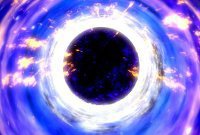Black holes to become colliders?
The experts of the Vienna Technical University in the field of elementary particle physics put forward an interesting, reasonable and economical proposal. They suggested using black holes to search for elementary particles, namely, axions. All attempts to catch them in accelerators on Earth have been unsuccessful.
Black holes, when absorbed, give particles very high energy, that is, dispersed them in nearly infinite rotation of the accretion disk, and as a result, axions elusive on Earth can be detected.

It was proposed to use these enormous cosmic "eaters" to work in place of pilot accelerators. They do not have to be built - a huge number of objects in space have been performing their mysterious to mankind absorption function of matter and energy (even in the form of photons). In addition, they do not need to be financed, repaired, and the results obtained may be simply incomparable to those obtained on Earth through incredible efforts. If this idea is fruitful, it will be a breakthrough in the physics of elementary particles.
All efforts to detect axions - pseudoscalar particles (these particles are called baryons, heavy particles) when they appear as the quantization of a particle with a wavelength of up to several kilometers, formed by the interaction of photons and high energy atomic nuclei, have been in vain.
Axions can "clean" the quantum chromodynamics of the problem of strong CP-violation (which manifests itself in violation of the decays of heavy particles in normal light particles and antiparticles - the latter appear less frequently than predicted by theory), which "blurs" the coherent theory. The attempts to find that "cleaning agent" represented by the particle-boson as conceived by the theorists on Earth have not been successful.
Largest laboratories - CERN, ADMX and the PVLAS - attempted to detect axions in various reactions. The latter even announced their discovery, but did not manage to actually capture them. They were looking for them in solar radiation due to the Primakoff effect and also could not find their location. The galactic halo dark matter was once declared their location, but this search also did not yeild results. The elusive axion has not been detected.
The proposal of the young researchers in physics at Vienna University of Technology, Daniel Grumiller and Gabriela Mocanu, whose work on the subject was published in Physical Review D, is elegant and simple. To search for these elusive pseudoscalar particles, more powerful accelerators are needed, and black holes are suitable for this role. They speed up part of the matter that falls into their gravitational field to such speeds that it flies off into space.
This phenomenon is studied by theoretic Penrose: as a result, the rotation of the black hole slows down to zero in theory, that is, to a complete stop. But this is a theoretical refinement of options of the existence of black holes, and for the search for elementary particles it is important that the condensed bosonic cloud near the black hole is accelerated stronger than it is possible in terrestrial accelerators.
A completely different problem arises - creation of recording technology for the cosmic axions. Presumably there are plenty of dispersed bosons, and their mass should produce gravitational waves that physicists are able to measure.
Axions are a type of bosons. They live long enough in the same quantum state, and entire clouds of bosons can accumulate around black holes. Presumably, such clouds can collapse catastrophically, forming "a new boson," by analogy with a new star, when a collapse of the cloud produces powerful "flash" bosons, carrying away axions into space at enormous velocity.
In accordance with the above mentioned Penrose process, a cloud can accumulate a lot of energy before a collapse, and as a result, it has to bend space-time. After that, gravitational waves will appear whose registration is possible in terrestrial laboratories. To record them, one needs to create highly sensitive sensors that can identify the gravitational wave passing through our planet from all of the many fluctuations.
This is a very complicated task, but certainly it will be solved in a few years, according to experts - presumably in 2016. Registration of gravitational waves due to cosmic cataclysm will be information for researchers of elementary particles, whose natural cosmic accelerators operate in deep space.
Tatiana Valchuk
Pravda.Ru
Subscribe to Pravda.Ru Telegram channel, Facebook, RSS!


